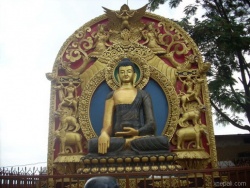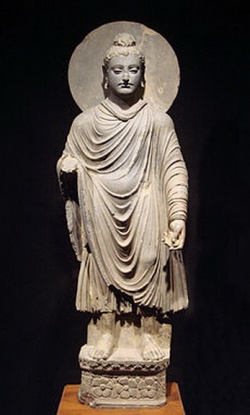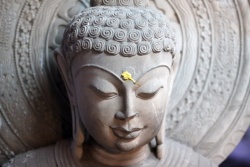Stages of the Eight Jhānas // Meditative Absorption
EIGHT JHĀNAS – In the Pāli canon the Buddha describes eight progressive states of absorption meditation or jhāna. Four are considered to be meditations of form (rūpa jhāna) and four are formless meditations (arūpa jhāna). The first four jhānas are said by the Buddha to be conducive to a pleasant abiding and freedom from suffering.[10] The jhānas are states of meditation where the mind is free from the five hindrances — craving, aversion, sloth, agitation and doubt — and (from the second jhāna onwards) incapable of discursive thinking. The deeper jhānas can last for many hours. Jhāna empowers a meditator’s mind, making it able to penetrate into the deepest truths of existence.
There are four deeper states of meditative absorption called “the immaterial attainments.” Sometimes these are also referred to as the “formless” jhānas (arūpa jhānas) in distinction from the first four jhānas (rūpa jhānas). In the Buddhist canonical texts, the word “jhāna” is never explicitly used to denote them, but they are always mentioned in sequence after the first four jhānas. The enlightenment of complete dwelling in emptiness is reached when the eighth jhāna is transcended.
The Rupa Jhānas
There are four stages of deep collectedness which are called the Rupa Jhāna (Fine-material Jhāna):
- First Jhāna – In the first jhana there are – “directed thought, evaluation, rapture, pleasure, unification of mind, contact, feeling, perception, intention, consciousness, desire, decision, persistence, mindfulness, equanimity & attention”
- Second Jhāna – In the second jhana there are – “internal assurance, rapture, pleasure, unification of mind, contact, feeling, perception, intention, consciousness, desire, decision, persistence, mindfulness, equanimity, & attention”
- Third Jhāna – In the third jhana, there are – “equanimity-pleasure, unification of mind, contact, feeling, perception, intention, consciousness, desire, decision, persistence, mindfulness, equanimity & attention”
- Fourth Jhāna – In the fourth jhana there are – “a feeling of equanimity, neither pleasure nor pain; an unconcern due to serenity of awareness; unification of mind, contact, feeling, perception, intention, consciousness, desire, decision, persistence, mindfulness, equanimity & attention”.[11]
The Arupa Jhānas
Beyond the four jhānas lie four attainments, referred to in the early texts as aruppas. These are also referred to in commentarial literature as immaterial/the formless jhānas (arūpajhānas), also translated as The Formless Dimensions:
- Dimension of Infinite Space – In the dimension of infinite space there are – “the perception of the dimension of the infinitude of space, unification of mind, contact, feeling, perception, intention, consciousness, desire, decision, persistence, mindfulness, equanimity, & attention”
- Dimension of Infinite Consciousness – In the Dimension of infinite consciousness there are – “the perception of the dimension of the infinitude of consciousness, unification of mind, contact, feeling, perception, intention, consciousness, desire, decision, persistence, mindfulness, equanimity, & attention”
- Dimension of Nothingness – In the dimension of nothingness, there are – “the perception of the dimension of nothingness, singleness of mind, contact, feeling, perception, intention, consciousness, desire, decision, persistence, mindfulness, equanimity, & attention”
- Dimension of Neither Perception nor Non-Perception – About the role of this jhana it is said: “He emerged mindfully from that attainment. On emerging mindfully from that attainment, he regarded the past qualities that had ceased & changed: ‘So this is how these qualities, not having been, come into play. Having been, they vanish.’ He remained unattracted & unrepelled with regard to those qualities, independent, detached, released, dissociated, with an awareness rid of barriers. He discerned that ‘There is a further escape,’ and pursuing it there really was for him.”
( Source : Wikipedia // Dhyāna in Buddhism )
The four Arūpajhāna
While rupajhanas differ considering their characteristics, arupajhanas differ as their object is determined by the level of the jhana:
- fifth jhāna: infinite space,
- sixth jhāna: infinite consciousness,
- seventh jhāna: infinite nothingness,
- eighth jhāna: neither perception nor non-perception.
This has to be understood. In the fourth rupajhana, there is already Upekkha, equanimity and Ekkagata, concentration, but the mind is still focused on a “material” object, as any color.
- In the fifth jhana, the meditator discovers that there is no object, but only an infinite space, which is empty. This perception motivates the interest of claiming arupajhanas.
- In the sixth jhana, it becomes obvious that space has no existence. There is only infinite consciousness.
- In the seventh jhana appears the feeling that there is no consciousness, but nothingness.
- The eighth jhana consists in the most discrete possible state of mind, which justifies the using of “neither perception nor non-perception”.
These “explanations” do not refer to any intellectual, philosophical comprehension, which disappear since the second jhana. They attempt to figure mental process. The arūpajhānas are part of the kammatthanas, and are referred to as the four “formless states”. The two elements of Arūpajhāna
Some Tipitaka texts identify arūpajhānas as a part of the fourth rūpajhāna, as they include two elements: upekkhā (Sanskrit: upekṣā) and ekaggatā (Skt: ekāgratā).
Upekkha
Upekkhā is a Pali word meaning equanimity. The opposition between comfortable sensations and uncomfortable ones disappears. More importantly, it is one of the fourth Jhāna’s factors, present only in this Jhāna.
Ekaggatā
Ekaggatā or “singlepointedness”, as a Jhāna’s factor, simply means a very deep concentration, which includes the ceasing of stimuli from the exterior world. It is the only jhānic factor present in each Jhāna.



